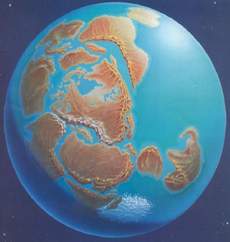Earth's moving continents to collide into one super-mainland in billion years
Continents can be likened to icebreakers navigating through the ice field that changes all the time
A 3-D spherical geodynamic model of modern Earth was designed by scientists at the Schmidt Institute of Earth's Physics of the Russian Academy of Sciences. The model is said to have the most complete description of geodynamics of our planet. The author of the model, Valery Trubitsyn, Corresponding Member of the Russian Academy of Sciences, head of laboratory of theoretical geodynamics, calls it a theory of tectonics of the continents floating on the convective mantle. Mr. Trubitsyn points out that his model does not contradict the longstanding theory of tectonics of platforms. 
The theory of tectonics of platforms views Earth as a heat engine where the convective mantle is a boiler and the lithosphere platforms comprising the ocean bottom work as connecting rods. Magma draws apart the middle oceanic ridges as it breaks through them and thus magma makes the continents move around.
However, this theoretical description can not explain why magma's heat flow over the continent happens to be reduced by 3 times as opposed to that over the oceans. Until now many geophysicists have tried to explain the phenomenon by pointing out to chaotic processes. They believed the continents had no impact on the platform drift.
Vladimir Trunitsyn came up with a new concept. According to him, continents act as governors in a heat engine. Temperature at the earth's surface (~3000 Kelvin) is considerably lower than the melting point of the mantle matter (~17000 K). That is why the continents can be likened to icebreakers navigating through the ice field that changes all the time. “Ice” that is temporarily stuck to the sides of the continents equals the ocean's lithosphere in the passive outskirts of the continents. In the meantime, “ice” that covers the bottom is the continental lithosphere. Unlike ice (ice is lighter than water), heavy ocean lithosphere does not sit in the active outskirts of the continents. It slides down under the continents. The heat flow coming from the mantle through the continents is weaker by 3 times than that blowing across the oceans. That is why the floating continents fundamentally change all evolution of the mantle currents.
The author of the new theory believes that modern computing equipment will enable scientists to make calculations regarding tension in the continents that leads to earthquakes. Equipment can also be used for the prospecting of new deposits of mineral resources. It is noteworthy that the new geodynamic model of Earth can be also applied when studying other planets of the solar system.
Venus, Earth, and Mars form an evolutional sequence. The planets are gigantic nuclear reactors. The heat of decay of uranium and thorium constantly feeds the initial heating of the planets. Venus stays hot and covered with a thick crust like a sarcophagus. That is the reason why Venus blows up once in a billion years. Mars is much cooler. Heat is removed by means of volcanoes on Mars. Meanwhile, the moving continents control the heat removal from the earth's mantle. The continents constantly move away from the site of the maximum heat flow coming through the ocean bottom. In other words, the ocean bottom resembles windows showing convection in the earth's mantle.
Subscribe to Pravda.Ru Telegram channel, Facebook, RSS!




